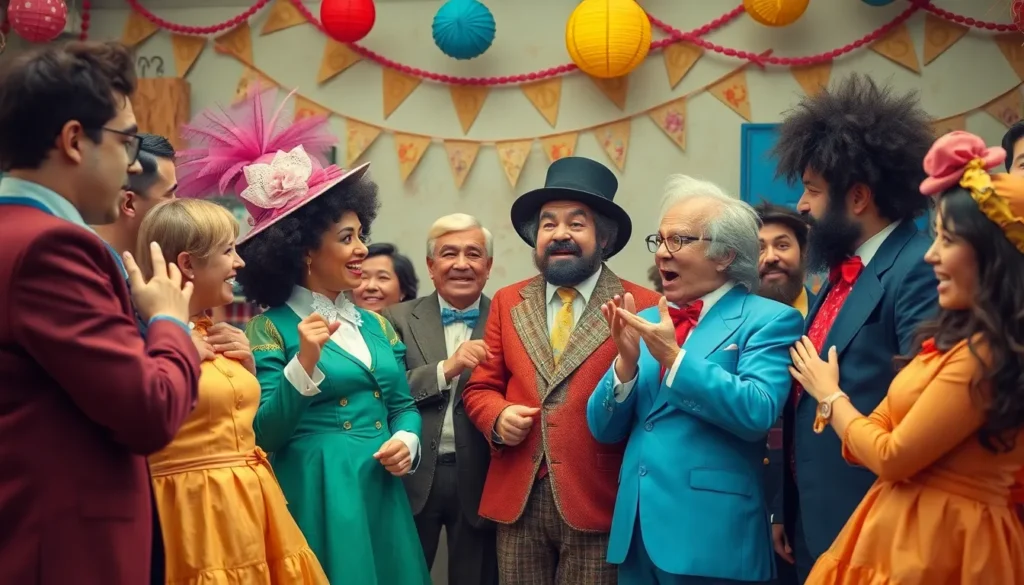Table of Contents
ToggleSatire in movies isn’t just about making audiences laugh; it’s a clever tool that holds a mirror to society’s quirks and absurdities. Picture this: a film that pokes fun at politics while keeping you in stitches. That’s the magic of satire. It’s where humor meets critique, inviting viewers to reflect on the world around them while they enjoy a good chuckle.
From biting political commentary to playful jabs at cultural norms, satire has carved out a unique niche in cinema. It challenges conventions and sparks conversations, all while entertaining. So, whether it’s a classic like “Dr. Strangelove” or a modern gem like “The Death of Stalin,” these films prove that laughter really is the best medicine—for both the soul and society. Dive into the world of satirical cinema and discover how humor can be both a weapon and a balm.
Understanding Satire in Movies
Satire in movies provides both entertainment and a critical lens on society. Through humor and irony, filmmakers address complex issues, prompting viewers to engage in deeper reflections.
Definition of Satire
Satire uses wit, irony, or exaggeration to expose or criticize societal flaws. Movies often employ this technique to comment on politics, culture, and human behavior. Characters and scenarios become amplifications of real-world problems. By highlighting the absurdities of certain beliefs or actions, satirical films prompt audiences to rethink their perspectives. This art form blends comedy and critique, making serious topics more approachable and thought-provoking.
Historical Context of Satire in Film
The roots of satire in film trace back to early cinematic works. Silent films like “The General” showcased humor while critiquing war. The 1960s saw classics like “Dr. Strangelove,” which satirized Cold War tensions. Subsequent decades introduced films such as “The Death of Stalin,” highlighting the contradictions of political regimes. Each era brought unique challenges and events for filmmakers to address. Today, satire continues to evolve, reflecting contemporary issues and societal shifts. Through this evolution, audiences gain insights into the complexities of human nature and power dynamics.
Key Elements of Satirical Films

Satirical films often combine humor and critical insights, making them distinctive within cinema. They convey messages about society while entertaining audiences.
Humor and Irony
Humor drives satirical films, employing exaggeration and absurdity to highlight flaws. Irony features prominently, contrasting expectations and reality. For instance, characters may find themselves in ludicrous situations, exposing the ridiculous nature of real-life events. Comedic timing amplifies the impact of the satire, allowing the audience to laugh while pondering deeper truths. Classic examples like “Dr. Strangelove” demonstrate how humor becomes a vehicle for serious commentary.
Social Commentary
Social commentary stands at the heart of satirical films, addressing pressing issues through a lens of wit. Filmmakers critique political landscapes, cultural norms, and societal behaviors. Universal themes emerge, engaging viewers in conversations about power dynamics and ethical dilemmas. “The Death of Stalin” showcases how laughter can navigate controversial subjects, prompting reflections on history’s absurdities. Through this lens, satire drives home essential points while sparking dialogue among audiences.
Notable Examples of Satire in Movies
Satire finds expression in many films, reflecting societal issues with wit and humor. Classic examples showcase the art of satire rooted in early cinema.
Classic Satirical Films
“Dr. Strangelove” stands as a seminal example, using absurdity to critique Cold War politics. This Stanley Kubrick film exposes the irrationality of nuclear war through dark humor. Another classic, “The General,” illustrates early satirical filmmaking, blending comedy with a critical view of war and human folly. Audiences recognize the blend of humor and poignant commentary in these masterpieces. Each film encourages reflection on the absurdities of their respective eras.
Modern Satirical Works
“Get Out” uses horror elements to address racism, blending satire with social commentary. Jordan Peele’s film remains a powerful exploration of contemporary issues, earning critical acclaim. “The Death of Stalin” employs humor to critique political power, showcasing the absurdity of leadership. This dark comedy relays significant historical commentary while engaging its viewers. Each modern work captures current societal challenges, proving that satire remains relevant across decades.
The Impact of Satire on Society
Satire influences society by shaping public discourse and opinions.
Influencing Public Opinion
Satirical films often provoke thought by exposing absurdities in political or social systems. They challenge widely accepted beliefs, urging audiences to question authority. Viewers frequently find themselves laughing while reflecting on serious issues, as laughter creates a channel for difficult conversations. Films like “Dr. Strangelove” illustrate how satire can sway public sentiment by highlighting the irrationality of political decisions. It also fosters awareness and discussion, leading to critiques of societal norms. Audiences engage with the material and share perspectives, enhancing collective understanding. The impact of such films can ripple through society, inspiring movements and encouraging activism.
Reflection of Cultural Issues
Cultural issues often find a voice through satire in film. Comedies like “The Death of Stalin” highlight power struggles and moral dilemmas while entertaining viewers. These films emphasize the disconnect between reality and expectation, often revealing deep-rooted flaws in societal structures. As filmmakers address racism, inequality, and corruption, they create dialogue around these topics, encouraging viewers to reflect on their implications. Audiences relate to satirical portrayals of everyday life, making complex issues more accessible. This connection fosters empathy and critical thinking, driving home the relevance of cultural commentary in today’s world. Ultimately, satire serves as a potent lens through which society examines itself.
Satire in movies serves as a powerful vehicle for social critique and reflection. Through humor and irony, filmmakers challenge audiences to confront uncomfortable truths about society and politics. The ability of satire to provoke thought while entertaining ensures its lasting relevance in contemporary cinema.
As viewers engage with these films, they not only laugh but also ponder deeper issues that affect their lives. The evolution of satire from classic works to modern narratives demonstrates its adaptability and significance in shaping public discourse. Ultimately, satire remains a vital art form that encourages viewers to question norms and inspires change through laughter.







